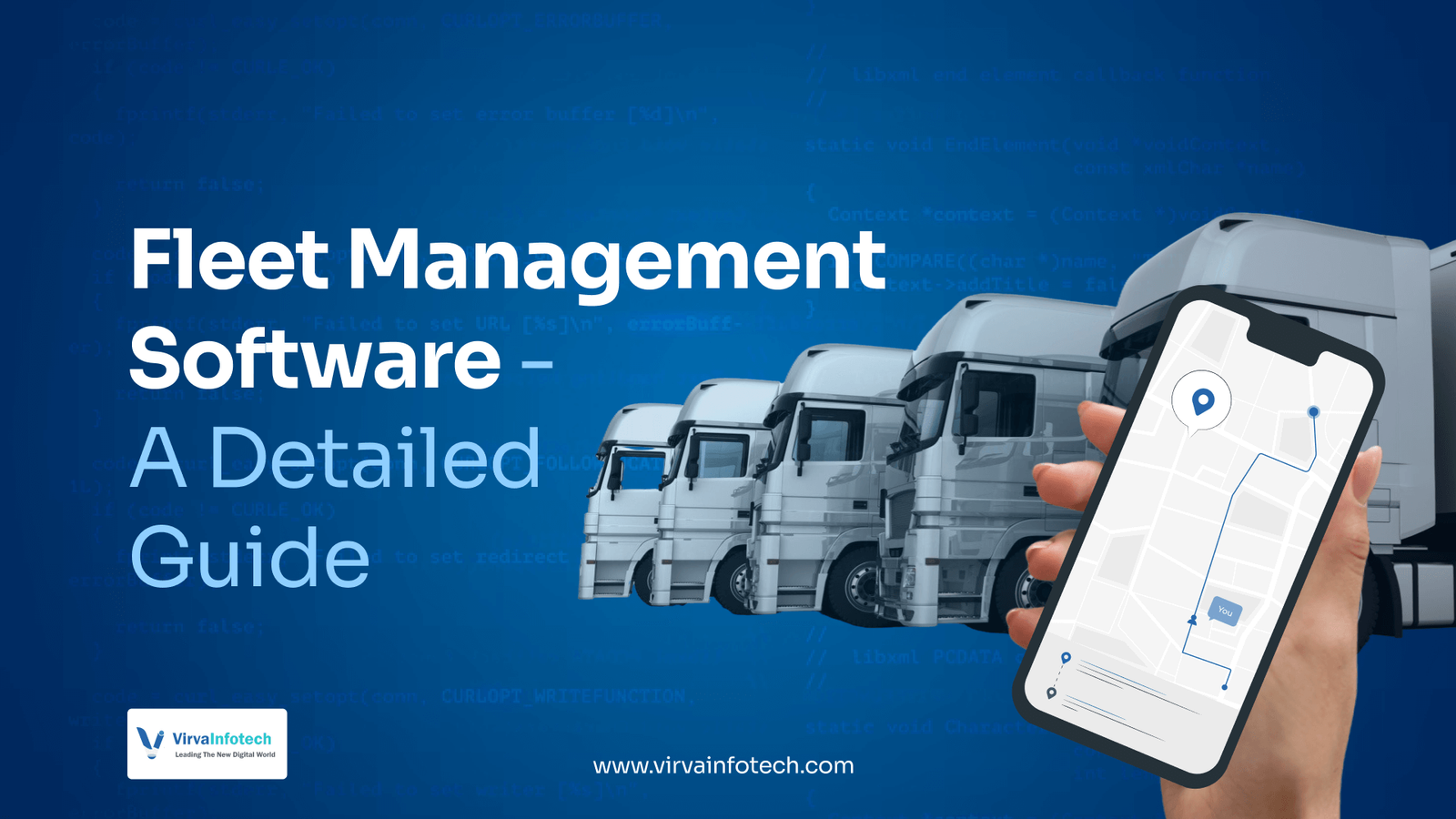Posted At: Jul 01, 2025 - 149 Views

What is Fleet Management Software?
Fleet Management Software (FMS) is a digital solution designed to help businesses manage, track, and maintain their vehicle fleets efficiently. It integrates data from GPS devices, vehicle sensors, and driver inputs to offer real-time insights into fleet operations.
It works as a centralised platform for tasks like:
- Vehicle tracking
- Maintenance scheduling
- Fuel consumption monitoring
- Route optimization
- Driver behaviour analysis
This software is often used in combination with a GPS fleet management system, vehicle tracking software, or even a vehicle tracking app for mobile access.
Benefits of Fleet Management Software
Improved Operational Efficiency:
Fleet management software automates tasks like dispatching, route planning, and reporting. This reduces manual work and human error, leading to smoother and faster operations. Managers get real-time data to make quicker, more informed decisions.
Real-Time Vehicle Tracking:
Through GPS tracking, it becomes possible to monitor each vehicle's exact location and speed and observe the route in real time. This visibility aids in instant detection of delays or route deviations, thereby allowing better control and coordination across the fleet.
Reduced Fuel and Maintenance Costs:
The system identifies inefficient driving behaviours, such as idling or harsh braking, and works towards reducing fuel wastage. Additionally, it issues timely attention or maintenance alerts that receive proper action, keeping vehicles from expensive repairs and running longer and efficiently.
Enhanced Safety:
Driver behaviour is closely monitored for risky actions like speeding or sudden braking. Managers receive alerts and can take action quickly, such as providing coaching or corrective steps, which lowers accident risks and improves road safety.
Regulatory Compliance:
The software helps you meet legal requirements like ELD compliance and hours-of-service rules. It automatically logs driving hours, inspection reports, and other key data needed for audits, reducing the risk of penalties.
Better Customer Service:
Accurate real-time tracking allows for precise ETAs and quicker response times. This means customers are better informed and more satisfied, leading to improved reliability and trust in your services.
Top Fleet Management Software Features
1. Real-Time GPS Tracking:
This feature allows users to view the exact location, speed, and direction of every vehicle in real time. There is increased visibility throughout the whole fleet, helping in decision-making during delays, route changes, and emergencies. This is paramount for control and coordination.
2. Fleet Maintenance Alerts:
The system tracks mileage, engine hours, and service schedules, then sends timely alerts when maintenance is due. This helps prevent breakdowns, reduce repair costs, and extend the life of your vehicles. Staying ahead of maintenance also improves safety and uptime.
3. Driver Behaviour Monitoring:
Speeding, harsh braking, rapid acceleration, and excessive idling are some of the actions monitored. When managers receive alerts on unsafe driver behaviour, they will be able to provide coaching to improve safety. This limits the number of accidents and encourages fuel-efficient driving.
4. Fuel Usage Reporting:
Fuel is one of the highest operational costs in fleet management. It monitors consumption patterns and identifies those behaviours and vehicles that waste fuel. By utilising proper fuel reporting, the business may help streamline efficiency and eliminate unnecessary fuel costs.
5. Trip History & Route Optimisation:
This logs every trip taken by fleet vehicles, including routes, stops, and durations. Analysing trip history helps in identifying inefficiencies and planning more optimal routes in the future. This results in reduced fuel usage and faster deliveries.
6. Geofencing and Alerts:
Managers can assign or set boundaries on the map via geofencing. When vehicles cross such boundaries, the system issues an automatic alert. This serves well for monitoring deliveries, keeping tabs on unauthorised usage, or making sure that vehicles do not leave approved working zones.
7. Mobile Access via Vehicle Tracking App:
A mobile-friendly platform gives fleet managers access to key features while on the move. Through the app, they can track vehicles, view alerts, and communicate with drivers in real time, enabling faster response and better flexibility.
8. Integration with Telematics Software:
Modern fleet solutions integrate seamlessly with telematics systems to collect in-depth vehicle data like engine diagnostics, tire pressure, or battery health. This data helps in predictive maintenance and overall performance improvement.
9. Analytics & Reporting Dashboard
A robust dashboard compiles all fleet data into clear charts and reports. Managers can analyse performance trends, driver behaviour, maintenance costs, and route efficiency. These insights drive smarter business decisions and continuous improvement.
What Devices Are Used In Fleet Management Systems?
1. GPS Trackers
GPS trackers are one of the most essential devices in a fleet management system. They provide real-time location updates for every vehicle in the fleet. This helps managers track routes, monitor delays, and ensure vehicles are staying on course. GPS tracking also improves route planning, reduces fuel consumption, and enhances customer service by offering accurate ETAs. In case of emergencies or theft, GPS makes it easy to locate and recover the vehicle quickly.
2. OBD-II Devices
OBD-II (On-Board Diagnostics) devices plug into the vehicle's diagnostic port and collect detailed data on engine health and vehicle performance. These devices monitor parameters like check engine alerts, fuel system status, and emissions. With real-time diagnostic data, fleet managers can detect potential issues early and schedule maintenance before problems worsen. OBD-II devices are critical for ensuring compliance, reducing breakdowns, and extending vehicle lifespan.
3. Dashcams
Careful correlation can be made between the crashing incidents and dashcams or dashboard cameras that record live video of what's happening on the road. Dashcams are generally installed to ensure driver safety, set the facts right in case of an accident, or defend against false claims. Modern dashcams might provide AI-based driver monitoring, lane departure warnings, and collision warnings. The footage, therefore, can be leveraged for insurance claims, safety training, or to uncover reckless driving.
4. RFID Tags
Radio Frequency Identification tags are popularly used in tracking cargo and equipment or confirming driver identity. These tags are attached to objects or combined with driver ID cards. Upon scanning, they give information as to which driver accessed the vehicle or where in the plant the cargo is located. This, of course, can be of great help in logistics and warehousing operations, thereby improving the efficiency of inventory management and safeguarding against theft or losses. The RFID-based tracking system ensures that a clear chain of custody remains available for assets as well as drivers.
5. Telematics Devices
Telematics devices collect a great deal of data, such as speed, fuel consumption, engine RPM, braking patterns, and idle times. They combine GPS tracking with vehicle diagnostics to provide a thorough insight into driver behaviour and vehicle condition. The devices become paramount in enhancing fleet efficiency, cutting down operational costs, and ensuring regulatory compliance. Therefore, a business, with telematics, observes a holistic picture of fleet performance.
Types of Fleet Management Software
1. Cloud-Based Fleet Software
Cloud-based fleet software is hosted on remote servers and accessed through the internet using a web browser or mobile app. It allows fleet managers to monitor and manage operations from anywhere at any time. This type of system is highly scalable, making it ideal for growing businesses or those with multiple locations. Updates, data backups, and maintenance are handled automatically by the service provider, reducing the need for internal IT resources. It also offers real-time data access and easy integration with other digital tools.
2. On-Premise Fleet Software
On-premise fleet software is installed and hosted within the company infrastructure on local servers and hardware. This type of system is typically selected by organisations requiring maximum control over data security and privacy: government agencies or large enterprises are prime examples. Hence, one can say it allows for a higher degree of customisation but demands the presence of an IT team to update, maintain, and support the system. Although they usually entail a higher upfront investment, they grant the business full ownership and control over the software and data.
3. Hybrid Systems:
Hybrid fleet management systems combine the advantages of both cloud-based and on-premise solutions. They offer the flexibility and accessibility of cloud systems along with the security and control of local servers. This setup is useful for businesses that want to keep sensitive data in-house while still accessing some features remotely. Hybrid systems also provide a balanced approach to performance, cost, and scalability. They are often customizable based on business needs.
4. Industry-Specific Solutions:
Industry-specific fleet management software is designed to meet the unique requirements of particular sectors like logistics, construction, public transport, or emergency services. These platforms come with specialised features such as load tracking, driver compliance checks, fleet scheduling, or asset management tools. For example, logistics companies may need real-time freight visibility, while construction firms might require equipment tracking. These solutions help businesses stay compliant and improve operational efficiency in their specific field.
Fleet Management Software Development Steps:
1. Define Your Goals
Before beginning development, it's essential to clearly define your goals. Identify the main features your business needs, such as real-time GPS tracking, fuel usage monitoring, maintenance reminders, or driver behaviour analytics. These goals will shape your system architecture, user flow, and overall functionality.
The clearer your requirements are from the start, the more efficient the development process becomes. This step also helps in determining the scope of the project, resource allocation, and choosing between a custom build or an existing white-label solution. Prioritising your features ensures your product serves your exact operational needs.
2. Choose the Right Tech Stack
Choosing the Right tech stack is crucial for the system’s performance and scalability. For backend development, Python, Node.js, or Java are solid options, offering robust data handling and API integration capabilities. For frontend development, frameworks like React or Angular provide responsive and user-friendly interfaces.
For mobile apps, Flutter and React Native are great choices due to their cross-platform compatibility, reducing time and cost. Also, consider the database technologies—like PostgreSQL or MongoDB—for storing vehicle, user, and trip data. Picking the right stack ensures long-term stability and easier maintenance.
3. Integrate Telematics and GPS APIs
Integration with telematics systems and GPS APIs is necessary to acquire the real-time data of the vehicle. These integrations feed the software from the API with inputs such as location, speed, engine diagnostics, and driver behaviour. Generally, APIs from Geotab, Samsara, or TomTom providers are employed for this.
An ideal integration will guarantee that your data is trusted, timely, and actionable. It also empowers prominent modules, such as live tracking, route history, and alert notifications. Without robust telematics integrations, the software cannot provide fundamental fleet insights.
4. Build Core Modules:
The Backbone of your software is building the correct core modules. Start with User Management, wherein admin and driver profiles will be created, roles assigned to them, and access levels controlled. A Vehicle Database should also be in place to hold the details such as Registration Numbers, Maintenance Records, and Telemetrics Data.
Further modules should be developed for Trip History, with data relating to past routes, durations, and stops. The Live Tracking Map offers a visual interface for showing how vehicles move in real time. Notifications and Alerts should be triggered for incidents like speeding and maintenance overdue. Lastly, the Reports Dashboard provides analysis on fuel consumption, driver behaviour, and vehicle status. All modules should hence be engineered with simplicity and precision towards data in mind.
5. Test & Deploy
Testing is a Critical stage in software development, especially for systems that depend on real-time data. Conduct unit tests, integration tests, along with load tests to verify if all modules work independently and together under real conditions, focusing greatly on areas where live GPS updates and alerts must be highly accurate.
Following testing, launch the software gradually, beginning with a pilot launch to a small fleet. Accumulate users' feedback to fix the bugs, after which you can proceed with a full deployment. This process will help ensure that there is no disruption during rollout and will make sure the system is stable from the very first day.
6. Post-Launch Support:
After launching your fleet management system, post-launch support is essential. This includes handling bug fixes, providing customer support, and pushing regular feature updates. A support team should be available to assist users, monitor system performance, and apply patches as needed.
Ongoing improvements not only keep the software competitive but also help you adapt to evolving regulatory requirements and business needs. Many companies also offer SaaS-based support models to ensure long-term reliability and customer satisfaction.
Conclusion
A smart fleet management solution is no longer optional—it’s essential for any business that operates multiple vehicles. From reducing costs and improving safety to optimising routes and complying with regulations, fleet management software streamlines operations like never before.
With the help of tools like vehicle tracking software, fleet monitoring software, and telematics software, businesses gain total control over their assets on the road.
Whether you're planning to buy, build, or upgrade your current vehicle fleet tracking system, the time to invest in modern fleet technology is now.


